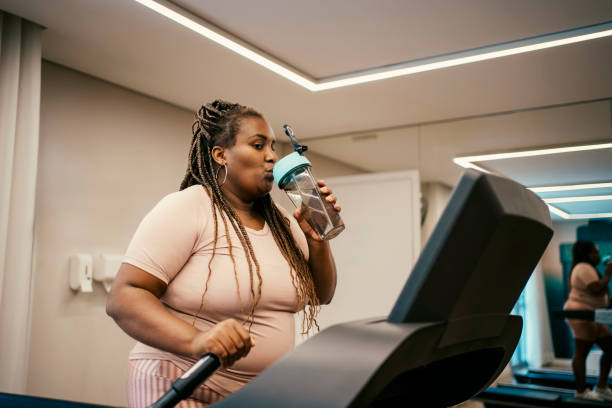(BlackFitness101.com) Balancing work and personal life can be challenging, especially when trying to maintain or improve your fitness level. Many people struggle with the demands of a full-time job, commuting, and personal responsibilities, leaving little time for exercise and healthy habits. However, getting in shape doesn’t have to be an overwhelming task that requires hours at the gym or strict diets. With the right strategies, you can integrate fitness into your daily routine without sacrificing your job or other commitments.
As a fitness trainer, I’ve worked with many clients who face the same dilemma. They want to get in shape but are unsure how to do so while managing a demanding career. The good news is that it’s entirely possible to achieve your fitness goals with a few adjustments to your routine and mindset. Here are seven tips that can help you get in shape while keeping your job.

1. Prioritize Your Time
One of the biggest challenges people face when trying to get in shape is finding the time to exercise. With a busy work schedule, it’s easy to put off workouts until “later,” which often turns into never. To avoid this, it’s essential to prioritize your time effectively.
Start with a Schedule: Begin by looking at your weekly schedule and identifying blocks of time that you can dedicate to exercise. This might mean waking up an hour earlier to squeeze in a morning workout, using your lunch break for a quick gym session, or exercising after work before heading home.
Set Realistic Goals: It’s important to set achievable fitness goals based on the time you have available. If you only have 30 minutes a day to exercise, focus on high-intensity workouts that maximize calorie burn in a short amount of time. Consistency is key, so even shorter workouts can be effective if done regularly.
Eliminate Time-Wasters: Identify activities that consume your time without adding value to your day. This could be excessive social media scrolling, watching TV, or unnecessary meetings. Reducing or eliminating these activities can free up time for exercise.
2. Incorporate Movement into Your Day
You don’t have to be at the gym to get in shape. Incorporating more movement into your daily routine can significantly impact your fitness level, especially if you have a sedentary job.
Take Short Breaks: Sitting for long periods can lead to a host of health issues, including weight gain and decreased muscle tone. Combat this by taking short breaks to move around every hour. Stand up, stretch, walk around your office, or do a few bodyweight exercises like squats or push-ups.
Use Active Transportation: If possible, walk or bike to work instead of driving. If you use public transportation, get off a stop or two early and walk the rest of the way. These small changes can add up to significant calorie burn over time.
Opt for the Stairs: Choose stairs over elevators whenever possible. Climbing stairs is a great way to engage your lower body muscles and improve cardiovascular health. Make it a habit to take the stairs at work, even if it’s just for a few floors.
3. Optimize Your Nutrition
Exercise is only part of the equation when it comes to getting in shape. Nutrition plays a crucial role in your overall health and fitness. However, eating well can be challenging when you’re busy with work.
Plan Your Meals: Meal planning is an effective way to ensure you have healthy food options throughout the week. Take some time on the weekend to plan and prepare meals in advance. This reduces the temptation to grab unhealthy takeout or snacks during the workweek.
Eat Balanced Meals: Focus on eating balanced meals that include a mix of protein, healthy fats, and complex carbohydrates. Protein is essential for muscle repair and growth, while healthy fats provide sustained energy. Complex carbs, such as whole grains and vegetables, help keep you full and provide essential nutrients.
Stay Hydrated: Drinking enough water is crucial for overall health and can aid in weight loss by keeping you full and reducing cravings. Keep a water bottle at your desk and aim to drink at least eight glasses of water a day. If plain water is too boring, add a slice of lemon or cucumber for flavor.
4. Make the Most of Your Workouts
When you have limited time to exercise, it’s important to make every minute count. Focus on workouts that are efficient and effective, targeting multiple muscle groups and maximizing calorie burn.
High-Intensity Interval Training (HIIT): HIIT workouts involve short bursts of intense exercise followed by brief rest periods. This type of training is highly effective for burning calories and improving cardiovascular fitness in a short amount of time. A 20-30 minute HIIT workout can be as effective as an hour of steady-state cardio.
Compound Exercises: Compound exercises, such as squats, deadlifts, and bench presses, work multiple muscle groups simultaneously. This allows you to get more done in less time and burn more calories. Incorporating compound movements into your routine can help you build strength and muscle while improving your overall fitness.
Circuit Training: Circuit training involves performing a series of exercises with minimal rest between them. This keeps your heart rate elevated and provides both strength and cardiovascular benefits. You can create a circuit using bodyweight exercises, free weights, or resistance bands, depending on your fitness level and equipment availability.
5. Focus on Recovery and Sleep
Getting in shape isn’t just about working out—recovery and sleep are equally important. Your body needs time to repair and rebuild after exercise, and sleep is a critical component of this process.
Prioritize Sleep: Aim for 7-9 hours of sleep per night to allow your body to recover and function optimally. Lack of sleep can lead to increased stress, weight gain, and decreased performance in both your workouts and your job. Establish a bedtime routine to help you wind down and improve your sleep quality.
Incorporate Stretching: Stretching helps improve flexibility, reduce muscle soreness, and prevent injuries. Incorporate stretching into your daily routine, especially after workouts. Even a few minutes of stretching can make a big difference in how your body feels and performs.
Practice Active Recovery: Active recovery involves low-intensity exercise, such as walking, yoga, or light cycling, on your rest days. This helps increase blood flow to your muscles, reduce stiffness, and speed up recovery without putting additional strain on your body.
6. Stay Accountable
Staying motivated and accountable can be challenging when you’re trying to get in shape on your own. However, accountability is key to achieving your fitness goals.
Find a Workout Buddy: Exercising with a friend or coworker can make workouts more enjoyable and keep you accountable. You’re less likely to skip a workout if you know someone is counting on you to show up.
Join a Fitness Community: Whether it’s an online group or a local fitness class, being part of a community can provide motivation and support. Sharing your progress, challenges, and successes with others can help you stay committed to your fitness journey.
Set Milestones and Reward Yourself: Break your fitness goals into smaller milestones and reward yourself when you achieve them. This could be something as simple as treating yourself to a massage after a month of consistent workouts or buying new workout gear. Celebrating your progress can keep you motivated and focused on your long-term goals.
7. Manage Stress Effectively
Stress is a common obstacle to getting in shape, especially when balancing work and personal life. High stress levels can lead to emotional eating, lack of motivation, and burnout. Learning to manage stress effectively is crucial for both your physical and mental health.
Practice Mindfulness: Mindfulness techniques, such as meditation and deep breathing, can help reduce stress and improve focus. Even just a few minutes of mindfulness practice each day can have a positive impact on your overall well-being.
Exercise as Stress Relief: Physical activity is one of the best ways to relieve stress. Exercise releases endorphins, which are natural mood boosters. Whether it’s a brisk walk, a yoga session, or a weightlifting workout, find an activity that helps you unwind and manage stress.
Set Boundaries: It’s important to set boundaries between work and personal life to prevent burnout. Make time for activities that you enjoy and that help you relax, such as spending time with family, pursuing hobbies, or simply taking a break from screens. Setting boundaries will help you recharge and stay motivated in both your fitness journey and your career.
Getting in shape while keeping your job may seem daunting, but with the right approach, it’s entirely achievable. By prioritizing your time, incorporating movement into your day, optimizing your nutrition, making the most of your workouts, focusing on recovery and sleep, staying accountable, and managing stress, you can create a sustainable fitness routine that fits into your busy life.
Remember, consistency is key. Small, consistent efforts will lead to significant progress over time. With dedication and the right strategies, you can achieve your fitness goals without sacrificing your career or personal life. So, start implementing these tips today and take the first step towards a healthier, fitter you.
Staff Writer; Janet Banks
Questions? Feel free to email me at; JBanks@BlackFitness101.com.












Leave a Reply